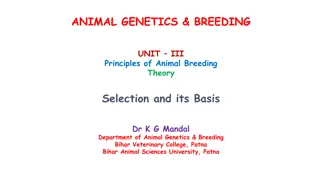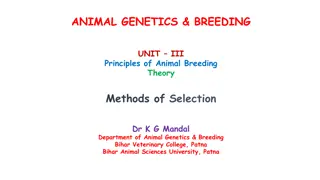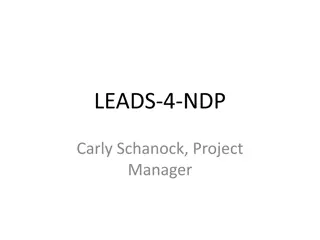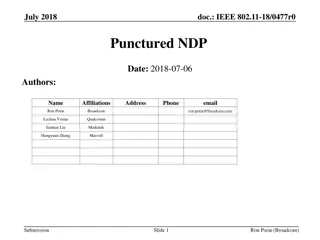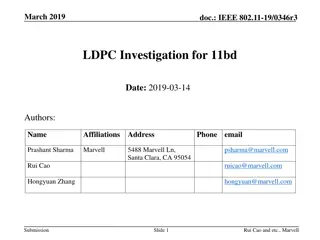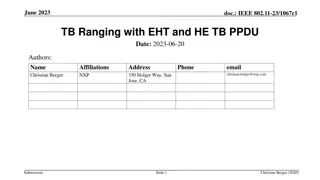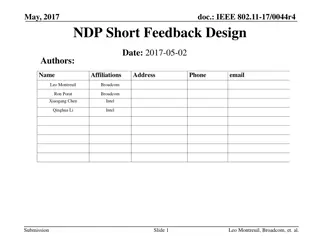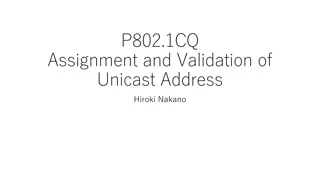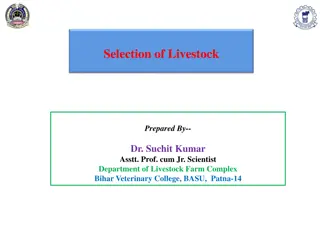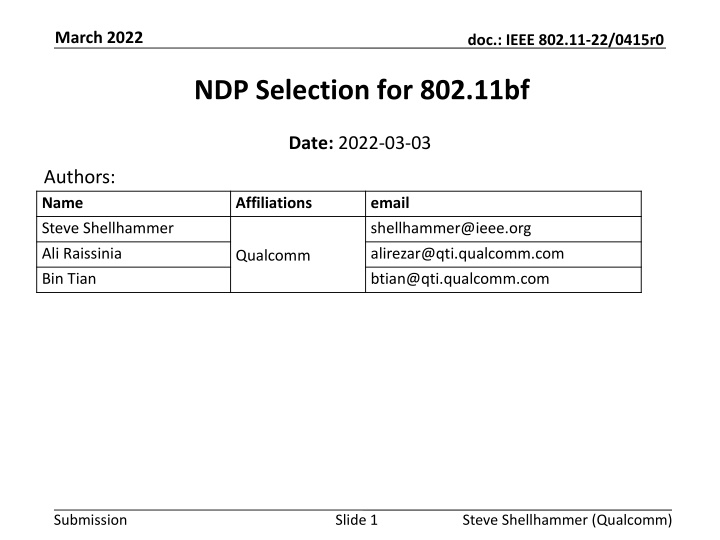
IEEE 802.11-22/0415r0 NDP Selection for 802.11bf Comparison
In this document, a comparison is provided between HE (TB) Ranging NDP and EHT NDP for the 802.11bf standard. Key parameters like LTF repetitions, secure LTFs, bandwidth support, and recommendation for selecting the HE Ranging NDP are discussed in detail.
Download Presentation

Please find below an Image/Link to download the presentation.
The content on the website is provided AS IS for your information and personal use only. It may not be sold, licensed, or shared on other websites without obtaining consent from the author. If you encounter any issues during the download, it is possible that the publisher has removed the file from their server.
You are allowed to download the files provided on this website for personal or commercial use, subject to the condition that they are used lawfully. All files are the property of their respective owners.
The content on the website is provided AS IS for your information and personal use only. It may not be sold, licensed, or shared on other websites without obtaining consent from the author.
E N D
Presentation Transcript
March 2022 doc.: IEEE 802.11-22/0415r0 NDP Selection for 802.11bf Date: 2022-03-03 Authors: Name Affiliations email Steve Shellhammer shellhammer@ieee.org Ali Raissinia Bin Tian alirezar@qti.qualcomm.com btian@qti.qualcomm.com Qualcomm Submission Slide 1 Steve Shellhammer (Qualcomm)
March 2022 doc.: IEEE 802.11-22/0415r0 Introduction The Task Group needs to decide which NPD will be supported in 802.11bf Here we provide a brief comparison between the HE (TB) Ranging NDP and the EHT NDP We provide two options and indicate our preference In the Backup we also provide some figures of the HE (TB) Ranging NDP and the EHT NDP Submission Slide 2 Steve Shellhammer (Qualcomm)
March 2022 doc.: IEEE 802.11-22/0415r0 NDP Comparison Parameter Comparison LTF Repetitions HE (TB) Ranging NDP supports LTF Repetitions LTF Repetitions can increase SNR, which is very important for RF Sensing Applications LTF Repetitions are also useful with Secure LTFs, to allow for consistency checks in channel estimation, to detect security attacks EHT NDP does not support LTF Repetitions, but it does allow the receiver to support more LTFs in an NDP that the number of supported spatial stream, allowing for an improved channel estimate. The receiver can indicate support for a total 4 or 8 LTFs, as long as that is larger than the number of spatial streams supported. Secure LTFs HE (TB) Ranging NDP supports Secure LTFs to prevent security attacks This is critical for secure ranging It may be useful for secure RF Sensing (more discussion required on this security topic) EHT NDP does not support Secure LTFs Bandwidths HE (TB) Ranging NDP supports 20, 40, 80 and 160 MHz Discussions are ongoing to add 320 MHz support to HE (TB) Ranging NDP in a future 802.11 task group (e.g., 802.11az+) EHT NDP supports 20, 40, 80, 160 and 320 MHz Puncturing EHT NDP supports multiple static puncturing modes 802.11az+ could support static puncturing of 320 MHz to enable 240 MHz bandwidth operation, which is useful in some regulatory domains Submission Slide 3 Steve Shellhammer (Qualcomm)
March 2022 doc.: IEEE 802.11-22/0415r0 Recommendation We think it is important to select one of these NDP versions We do not think it is a good idea to select multiple NDP versions since it will result in an exponential growth in the number of sensing measurement instances We recommend selection of the HE Ranging NDP o Since RF Sensing relies on measuring reflections from objects which may be weak reflections, the benefits of Repeated LTFs is extremely valuable, to increase the SNR to make measurement of the reflections possible When the Ranging NDP is extended to support 320 MHz, the RF Sensing will benefit from the larger bandwidth Submission Slide 4 Steve Shellhammer (Qualcomm)
March 2022 doc.: IEEE 802.11-22/0415r0 Straw Poll Do you agree that 802.11bf should support only the HE Ranging NDP and the HE TB Ranging NDP? Submission Slide 5 Steve Shellhammer (Qualcomm)
March 2022 doc.: IEEE 802.11-22/0415r0 Backup Submission Slide 6 Steve Shellhammer (Qualcomm)
March 2022 doc.: IEEE 802.11-22/0415r0 27.3.18a.1 HE Ranging NDP (11az) Submission Slide 7 Steve Shellhammer (Qualcomm)
March 2022 doc.: IEEE 802.11-22/0415r0 27.3.18a.2 HE TB Ranging NDP (11az) Submission Slide 8 Steve Shellhammer (Qualcomm)
March 2022 doc.: IEEE 802.11-22/0415r0 27.3.18a.1 HE Ranging NDP (11az) The HE Ranging NDP has the following properties: o No beamforming steering matrix is applied to the waveform. o Uses HE-LTFs or Secure HE-LTFs when the TXVECTOR parameter SECURE_LTF_FLAG is set to 0 or 1 respectively. o Has a Packet Extension (PE) field that is 4 s in duration. No energy is transmitted during the first 1.6 s of the PE field if the HE-LTF field is using the secure HE-LTF, similar to no energy being transmitted during the GI of HE-LTF symbols o The TXVECTOR parameter LTF_REP that indicates N_LTF_REP, the number of the HE-LTF repetitions. A value of N_LTF_REP equal to 1 indicates a single HE-LTF segment 34 without repetition, and a value of N_LTF_REP greater than 1 indicates the use of HE-LTF repetitions. o The only supported mode is 2x HE-LTF with 1.6 s GI o No energy is transmitted during the GI of the HE-LTF symbols when secure HE-LTF is used, which is referred to as a zero-power GI. o The number of HE-LTF symbols in an HE Ranging NDP depends on the number of space- time streams N_STS, the number of HE-LTF repetitions N_LTF_REP, and when Secure HE- LTFs are used, the number of users NUM_USERS. Submission Slide 9 Steve Shellhammer (Qualcomm)
March 2022 doc.: IEEE 802.11-22/0415r0 36.3.18 EHT sounding NDP (11be) Submission Slide 10 Steve Shellhammer (Qualcomm)
March 2022 doc.: IEEE 802.11-22/0415r0 36.3.18 EHT sounding NDP (11be) In the EHT sounding NDP, the 242-tone RUs overlapping the 20 MHz channels that are signaled as punctured through the Punctured Channel Indication field of the U-SIG field are punctured. The allowed punctured patterns are given in Table 36-30 (5-bit punctured channel indication for the non-OFDMA case in an EHT MU PPDU) It is mandatory to support the 2x EHT-LTF with 0.8 s GI and 2x EHT-LTF with 1.6 s GI. It is optional to support the 4x EHT-LTF with 3.2 s GI. The other combinations of EHT-LTF type and GI duration are disallowed. The EHT sounding NDP has a PE field that is given as follows: o 4 s when the PPDU bandwidth is less than or equal to 160 MHz and the number of spatial streams is less than or equal to 8. o 8 s for all the other cases Submission Slide 11 Steve Shellhammer (Qualcomm)



